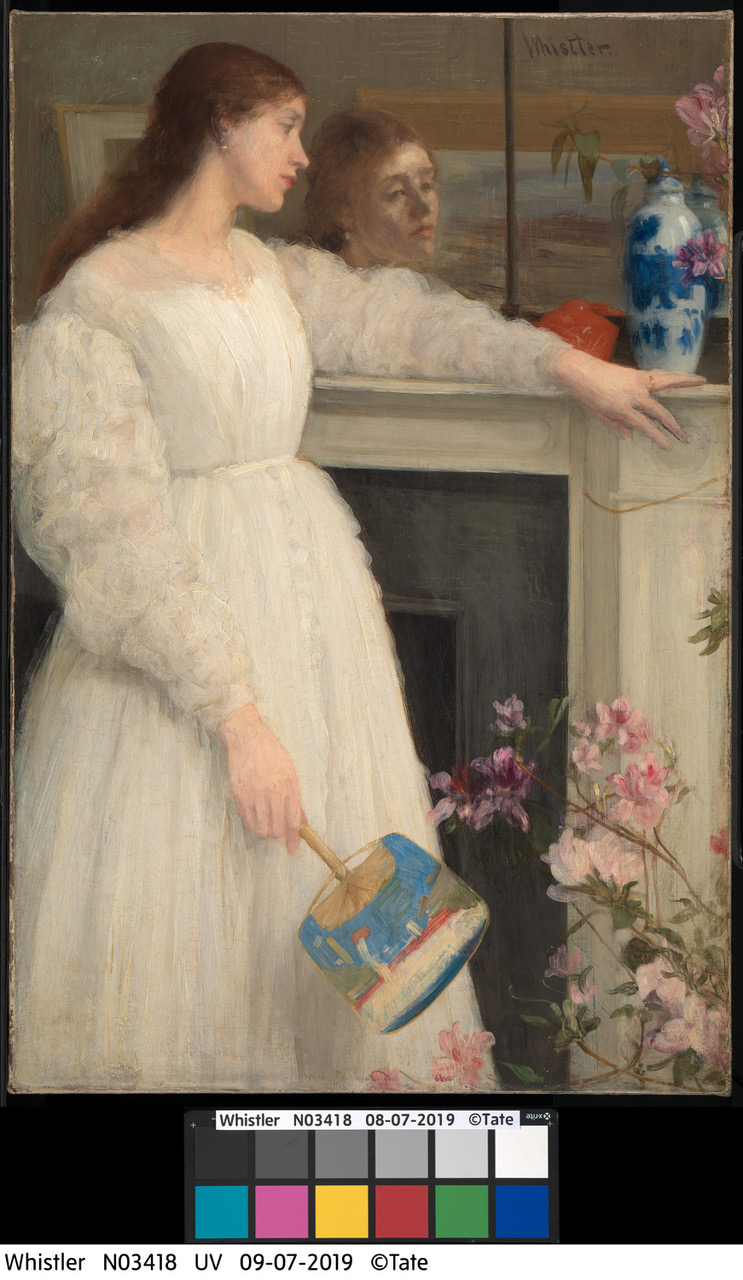
All Whistler’s colours in white
Colour Materiality
1864
As an art student in Paris in the mid-1850s, James Abbott McNeill Whistler learned from his teacher and fellow artist, Charles Gleyre, that black was a ‘universal harmonizer’ and the basis for tone. Its addition could lend richness and balance to every colour. That idea stayed with him all his life: every Whistler painting has at least a tiny amount of black in every brushstroke, including at least two of his three ‘Symphonies in White’ painted in the 1860s. The white dresses in each include not only black but also other carefully-selected colours that give life and subtlety to his portraits. The three all include Joanna Hiffernan as the model.
Symphony in White, No. 2 was painted in their house on Lindsey Row, Chelsea. Recent removal of an old and very yellowed varnish enables us to see anew this celebration in many shades of white of the unconventional and modern dress, worn without corsets or crinoline. Whistler’s ‘white’ paint includes red lake, yellow ochre, fine particles of blue ultramarine, and bone black, in places painted over a thinner layer of mixed dark grey for the grate. Symphony in White, No. 1 includes almost the same colours, namely red lake, red ochre, yellow ochre, ultramarine and a bluish black.
The building still exists. The fireplace is in a small but beautifully proportioned room with several windows. When the couple lived there, the view over the river was of smoking factory chimneys. London can be overcast and cloudy for days at a time, even before the smoke makes everything gloomier. So the subtle shades of white Whistler saw in Hiffernan’s dress probably do not reflect what was outdoors—they must have come from colours in the room. The highly glazed blue-and-white Chinese vase throws its colour onto the filmy white fabric at the wrist. Hiffernan’s rosy cheek and her arm resting on the mantelpiece with her pale skin showing through the filmy sleeve cast their colours onto her bodice.
The framed paintings between the windows, visible in the yellowed reflection of the mirror above the mantel, hang on a dull greenish wall, which is untypically light in tone for a Victorian interior. The bright blue, white, and scarlet of the Chinese ceramics and the pale pink of the flowers offer further examples of the very modern ‘aesthetic’ interior decoration which the couple had chosen.
Whistler used red lake to paint Hiffernan’s pale complexion, which sets off her chestnut hair and greenish eyes. More of this crimson colour shows up in the white-lined bodice—likely because the south light from the windows caught and warmed it as Whistler was painting. The pink azaleas cast their own reflection onto the front of Hiffernan’s skirt, but not the fabric toward the back; therefore Whistler added more blue there. The yellow we can see in the skirt might have been cast by the wooden floor, which in such a decorative scheme had likely been stripped of dark varnish, and sanded to give it a light tone. The fan in Hiffernan’s hand cast a simple dark shadow onto the white skirt because it blocked the light from the windows. This is a carefully orchestrated, brilliantly executed study in red, blue, yellow, green, black, and white, with endless nuances of white in between.
Bibliography
-
Stinis, Marte, From Colour to Music: James McNeill Whistler, Chromobase text, 2024.
-
Townsend, Joyce H., ‘Whistler's oil painting materials’, The Burlington Magazine, CXXXVI, 1994, pp.690–695.
-
Townsend, Joyce H., technical catalogue entries for Symphony in White, No.2, in Margaret F. MacDonald and Grischka Petri, James McNeill Whistler: The paintings, a catalogue raisonné, Glasgow, University of Glasgow, 2020.
-
Townsend, Joyce H., How Whistler Painted White in Full Color, National Gallery of Art blog posting (published 8/9/22).